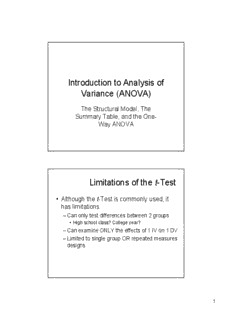
Introduction to Analysis of Variance (ANOVA) PDF
Preview Introduction to Analysis of Variance (ANOVA)
Introduction to Analysis of Variance (ANOVA) The Structural Model, The Summary Table, and the One- Way ANOVA Limitations of the t-Test • Although the t-Test is commonly used, it has limitations – Can only test differences between 2 groups • High school class? College year? – Can examine ONLY the effects of 1 IV on 1 DV – Limited to single group OR repeated measures designs 1 Limitations of the t-Test • Testing differences between group means – IV: Gender (Male & Female) – IV: High-school class (First-year, Sophomore, Junior, & Senior) – Using the t-Test, we must either “collapse” categories… or not run the analysis Limitations of the t-Test • 1 Independent Variable – Gender differences in depression • IV: Gender (Male & Female) • DV: Level of depression (BDI score) • 2 Independent Variables – Gender and social support on depression • IV : Gender (Male & Female) 1 • IV : Social support (High, Medium, & Low) 2 • DV: Level of depression (BDI score) 2 Limitations of the t-Test • 2 or more Independent Variables – Simultaneously examine the impact of 2 or more IVs on a single DV – Examine how the effects of 2 or more IVs COMBINE to affect a single DV Limitations of the t-Test • Single time point OR repeated measures designs – 1 group at 2 time points = repeated measures – 2 groups at 1 time point = independent groups • Single time point AND repeated measures designs – 2 or more groups at 2 or more time points 3 The Analysis of Variance (ANOVA) • The ANOVA can test hypotheses that the t-Test cannot • Probably the most commonly abused statistical test • Many varieties of ANOVA – One-Way (between subjects) – Factorial ANOVA (between or within subjects) – Repeated Measures (within subjects) – Mixed-Model (between & within subjects) Varieties of ANOVA • One-Way ANOVA – 1 continuous Dependent Variable – 1 Independent Variable consisting of 2 or more “categorical” groups • The one-way ANOVA with 2 groups is “equivalent” to the independent groups t-Test 4 Varieties of ANOVA • Factorial ANOVA – 1 continuous Dependent Variable – 2 or more Independent Variables consisting of 2 or more “categorical” groups for each IV • 2 IVs = Two-Way Factorial ANOVA • 3 IVs = Three-Way Factorial ANOVA – We call these “factorial” designs because EACH level of each IV is paired with EVERY level of ALL other IVs 2 x 2 Contingency Table IV 2 Level 1 Level 2 Level 1 DATA DATA Row 1 IV 1 Total Level 2 DATA DATA Row 2 Total Col 1 Total Col 2Total Note: Each Level 1 of IV 1 is paired with BOTH Level 1 and Level 2 of IV 2 5 2 x 2 Contingency Table Social Support High Low Male DATA DATA Row 1 Gender Total Female DATA DATA Row 2 Total Col 1 Total Col 2Total Note: Each Level 1 of IV 1 is paired with BOTH Level 1 and Level 2 of IV 2 Varieties of ANOVA • Repeated Measures ANOVA – Time points = IV – The DV is assessed at EACH time point 6 Varieties of ANOVA • Mixed-Model ANOVA – 1 continuous Dependent Variable – 1 or more Independent Variables consisting of 2 or more “categorical” groups (between) – 1 Independent Variable consisting of 2 or more “categorical” time points (within) • The DV is assessed at EACH time point ANOVA • ANOVA models we will consider – One-Way ANOVA – Two- and Three-way Factorial ANOVA – Repeated measures ANOVA – Mixed-model ANOVA 7 Choosing the Best Test The Underlying Model • A statistical model by example: • Assume: the average 18 year old human being weighs approximately 138 pounds – Men, on average, weigh 12 pounds more than the average human weight – Women, on average, weigh 10 pounds less than the average human weight 8 The Underlying Model • For any given human being, I can break weight down into 3 components: – Average weight for all individual • 138 lbs – Average weight for each group • Men: +12 lbs • Women: - 10 lbs – The individual’s unique difference The Underlying Model • Male weight Weight = 138 lbs + 12 lbs + uniqueness • Female weight Weight = 138 lbs – 10 lbs + uniqueness • If you understand this process, you understand the basic theory behind the ANOVA 9 Partitioning Variance • The idea behind the ANOVA test is to divide or separate (partition) variance observed in the data into categories of what we CAN and what we CANNOT explain Total Variance Explained Unexplained The Structural Model • Mathematically, we partition the total variance of our data using the structural form of the ANOVA model – X = µ + τ +ε ij j ij – The structural model translates as follows: The score for any single individual is equal to the sum of the population mean plus the mean of the group plus the individual’s unique contribution 10
Description: